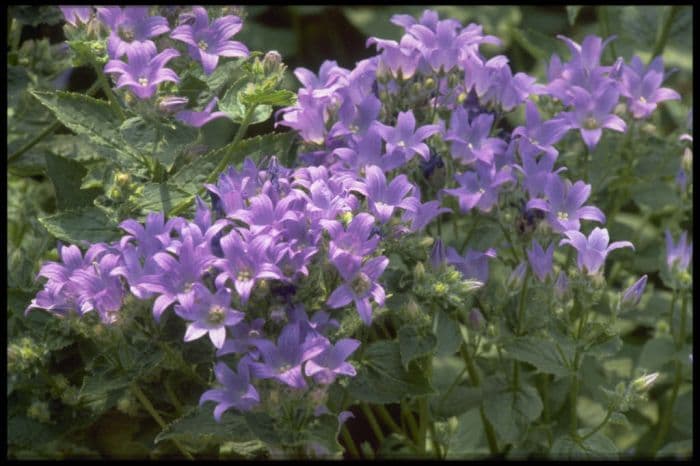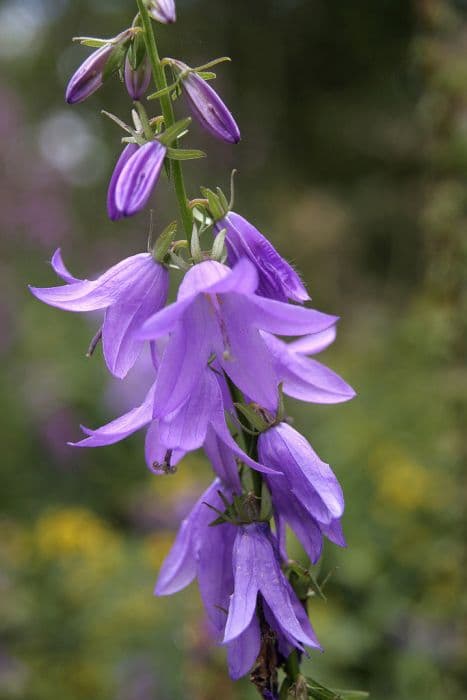Milky Bellflower Campanula lactiflora 'Prichard's Variety'

ABOUT
The Campanula lactiflora 'Prichard's Variety', commonly known as the Milky Bellflower, is a herbaceous perennial that showcases a plethora of attractive qualities. This plant produces a basal clump of long, narrow, toothed leaves that are medium to deep green in color and create a lush, verdant background for the flowers which bloom in the warmer months. The leaves themselves provide a textured appearance with their serrated edges and prominent veining. The real standout feature of the Milky Bellflower is its profusion of starry blooms. The flowers are bell-shaped and typically found in a beautiful shade of violet-blue, although they can sometimes appear with a more lavender hue. These vibrant blooms cluster along tall, upright stems that rise above the foliage like towers of color. Each individual flower is comprised of a bell-shaped corolla with five lobes that flare outwards, giving them a look of openness and elegance. Inside each blossom, delicate stamens protrude, adding a touch of contrasting color with their lighter shades. The mass of bell-like flowers creates a striking visual display that is not only appealing to the human eye but also to pollinators such as bees and butterflies, who frequently visit the plant for its nectar. The Milky Bellflower presents a romantic and cottage garden aesthetic, thanks to the contrast between the soft, sweeping lines of the foliage and the upright, punctuating presence of the flower spikes. Its dreamy color palette and graceful form have made it a favorite among gardeners looking to add a touch of whimsy and charm to their borders and flower beds.
About this plant
 Names
NamesFamily
Campanulaceae
Synonyms
Milky Bellflower, Broad-Leaved Bellflower
Common names
Campanula lactiflora 'Prichard's Variety'
 Toxicity
ToxicityTo humans
The Milky Bellflower is generally considered non-toxic to humans. Ingesting any part of this plant is usually not harmful, and there is no widespread documentation of poisoning or severe adverse effects from consumption.
To pets
The Milky Bellflower is not known to be toxic to pets either. It's not typically associated with poisoning in animals, so ingesting parts of this plant should not cause any significant symptoms or serious health consequences in pets. However, it's always advisable to prevent pets from eating plants as individual animals might have unique sensitivities.
 Characteristics
CharacteristicsLife cycle
Perennials
Foliage type
Deciduous
Color of leaves
Green
Flower color
Blue
Height
4 feet [1.2 meters]
Spread
2.5 feet [0.76 meters]
Plant type
Herb
Hardiness zones
5
Native area
Caucasus
Benefits
 General Benefits
General Benefits- Ornamental Value: Campanula lactiflora 'Prichard's Variety', commonly known as the Milky Bellflower, has attractive, star-shaped blue flowers that add aesthetic appeal to gardens and landscapes.
- Attracts Pollinators: The plant's flowers are a nectar source for bees and other beneficial insects, thereby supporting local ecosystems.
- Long Blooming Period: Milky Bellflower has a lengthy flowering season which ensures a display of color in the garden for an extended time, typically from early to late summer.
- Versatility in Landscaping: This plant can be used in borders, cottage gardens, and mixed beds, offering flexibility in garden design.
- Drought Tolerance: Once established, it has a good level of drought resistance, making it suitable for drier regions or for gardeners seeking plants with lower water requirements.
- Cold Hardy: This variety is known for its hardiness in cold temperatures, making it suitable for planting in various climates and extending its potential range.
- Maintenance: Generally low maintenance, requiring minimal care once established, which is ideal for both novice and experienced gardeners.
 Medical Properties
Medical PropertiesThis plant is not used for medical purposes.
 Air-purifying Qualities
Air-purifying QualitiesThis plant is not specifically known for air purifying qualities.
 Other Uses
Other Uses- Flower arrangements: Campanula lactiflora 'Prichard's Variety' with its tall, striking flowers, is perfect for adding height and a splash of color to both fresh and dried floral arrangements.
- Garden photography: The plant's attractive blooms and structure offer a beautiful subject for garden photographers looking to capture the essence of a perennial border.
- Educational tool: Horticulture students and botany enthusiasts can study the plant's growth habits, pollination mechanisms, and response to environmental factors as part of their educational curriculum.
- Pressed flowers: The blooms of Campanula lactiflora 'Prichard's Variety' can be pressed and used in botanical art, crafts, or as bookmarks.
- Wedding decor: Its ethereal blue flowers can be used in wedding bouquets, table centerpieces, and venue decorations, especially for garden or rustic-themed weddings.
- Fairy gardens: Gardeners can use the miniature versions of these plants to create whimsical fairy gardens and other imaginative garden displays.
- Plant dye: The flowers can potentially be used to produce a natural dye for fabrics or art projects, yielding soft blue or violet hues.
- Culinary garnish: While not commonly used as a food item, the flowers may be used as an edible decoration on cakes and desserts, assuming they are free of pesticides.
- Wildlife garden: The plant can be grown to attract pollinators such as bees and butterflies, thereby contributing to local biodiversity.
- Literary inspiration: Gardeners and writers alike may find inspiration in the plant's beauty and use it as a motif or metaphor in poetry and prose.
Interesting Facts
 Feng Shui
Feng ShuiThe Bellflower is not used in Feng Shui practice.
 Zodiac Sign Compitability
Zodiac Sign CompitabilityThe Bellflower is not used in astrology practice.
 Plant Symbolism
Plant Symbolism- Gratitude: The Campanula genus, also known as Bellflower, often symbolizes gratitude, conveying the message of appreciation and thanks.
- Constancy and Perseverance: With the bell-like shape and consistent blooming, Bellflowers represent everlasting love and the ability to overcome challenges.
- Humility: The graceful droop of the bell-shaped flowers can be associated with humility, suggesting a down-to-earth nature and modesty.
- Affection: Frequently found in cottage gardens, the Bellflower can also symbolize warm feelings and fondness for someone, perhaps due to its comforting and homely appearance.
 Water
WaterThe Milky Bellflower requires regular watering, ideally twice a week, to keep the soil consistently moist but not waterlogged. During the growing season in spring and summer, water thoroughly with about 1-1.5 gallons per plant, making sure the water penetrates deeply into the soil to reach the roots. Reduce watering frequency to once a week or when the top inch of soil feels dry during the cooler months. It's essential to avoid overhead watering to prevent leaf spot diseases, so always water at the base of the plant.
 Light
LightThe Milky Bellflower thrives best in full sun to partial shade. It should be placed where it can receive at least 4-6 hours of sunlight daily. An ideal spot would be one that gets morning sunlight and is shaded during the hottest part of the afternoon to protect the plant from scorching.
 Temperature
TemperatureThe Milky Bellflower can tolerate a wide range of temperatures but grows best in conditions between 60°F and 75°F. It can survive minimum temperatures down to about 20°F. Extreme heat over 85°F or frost below 20°F can harm the plant.
 Pruning
PruningThe Milky Bellflower should be pruned to remove dead or faded flowers to encourage new growth and a second bloom in the same season. Pruning is also necessary to maintain the desired shape and size of the plant. The best time for pruning is shortly after the first flowering period ends, usually in midsummer.
 Cleaning
CleaningAs needed
 Soil
SoilThe Milky Bellflower ('Prichard's Variety') thrives in a soil mix that is well-draining, fertile, and humus-rich. Loam or sandy loam soil amended with organic matter such as compost is ideal. The best pH for this plant is neutral to slightly alkaline, ranging from 6.5 to 7.5.
 Repotting
RepottingMilky Bellflower ('Prichard's Variety') typically doesn’t require frequent repotting as it is not a container-bound plant. It should be repotted or divided every 2-3 years to maintain its vigor and to manage its spread in the garden.
 Humidity & Misting
Humidity & MistingMilky Bellflower ('Prichard's Variety') prefers moderate humidity levels but is quite adaptable to different humidity conditions in the garden. It does not require specific humidity control if grown outdoors.
 Suitable locations
Suitable locationsIndoor
Ensure bright indirect light and consistent moisture for best growth.
Outdoor
Plant in partial shade, rich soil, and provide moderate watering.
Hardiness zone
3-8 USDA
 Life cycle
Life cycleCampanula lactiflora 'Prichard's Variety', commonly known as the Milky Bellflower, begins its life cycle when seeds are sown in the soil in spring after the last frost or started indoors before transplanting. The seeds germinate and develop into seedlings, which grow and form a rosette of basal leaves at the ground level. As the plant matures, it sends up flowering stems in early to midsummer that can reach up to 4 feet tall, bearing clusters of bell-shaped, lavender-blue flowers which attract pollinators. After blooming, the flowers produce seeds that mature by late summer to early fall, completing the reproductive cycle. The plant may become dormant in winter, especially in colder climates, dying back to the ground level before resurging with new growth in the following spring. If provided with optimal growing conditions, including well-draining soil and full sun to part shade, the plant may live several years, behaving as a perennial, and continue this cycle.
 Propogation
PropogationPropogation time
Spring to early summer
The most popular method of propagation for the Campanula lactiflora 'Prichard's Variety', commonly known as the Milky Bellflower, is by division. This process is best done in either spring or early fall when the plant is not in full bloom. To propagate by division, carefully dig up the plant and gently separate it into smaller clumps, ensuring that each new section has a portion of the root system intact. Replant the divisions at the same depth they were originally growing, spacing them about 12 inches (30 centimeters) apart to allow ample room for growth. Water the new plants thoroughly after planting to help establish them. This method of division helps promote vigorous growth and can rejuvenate older clumps that might have become woody or less floriferous over time.








